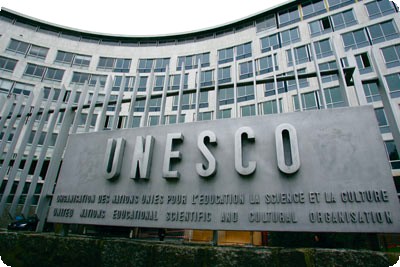
A graduate seminar has been offered in the Spring semester at George Washington University for each of the past three years titled "UNESCO: Agenda for the 21st Century". Most students have been at the Masters level. The students meet for two hours, once per week for 14 weeks. The course is offered within the International Education Program of the university, but is open to students from other departments and even from other universities in the Washington region. The course is coordinated by officers of Americans for UNESCO, and many members of the Board of Directors have participated actively in its sessions and by advising students on class projects.
Click here for the syllabus.
Prior to the class there was a posting that explains a key orientation for the effort:

How to Understand Intergovernmental Organizations
During the las semester each of the sessions of the class was described briefly in a blog posting. Those postings are:- UNESCO: Agenda for the 21st Century: The first session is a description of the course led by the coordinators, Frank Method and John Daly.
- The Dick and Ray Show: A presentation on the early history of UNESCO by Richard Arndt and Raymond Wanner, two experts on the topic.
- Education for All: The flagship effort of the UNESCO education program in the first of the student led classes. See also Education for All: Class of 2015, a video used in the class.
- The Other Education Programs of UNESCO: This first review of a specific program of UNESCO is described in some detail; a student led class.
- After EFA: What Next: This was an exercise in which students played the roles of UNESCO's educational stakeholders, led by Frank Method.
- UNESCO's World Heritage Center: The World Heritage program is UNESCO's best known and best loved effort; a student led class.
- Comments on the Budget of UNESCO: This was a supplement to the classroom materials, explaining the 2008-2009 budget in broad terms.
- Comments on the Culture Program: Describing the rest of the Culture program of UNESCO; a student led session.
- Class Exercise: ExBrd Working Group on Old City of Jerusalem: An exercise in which students played the roles of a Executive Board working group that met in 2007, led by John Daly.
- A Comment on the Natural Science Program of UNESCO: A student led class.
- Class: The Social and Human Sciences Program of UNESCO: A student led class.
- Why is UNESCO the Way it is? This posting summarized a means of understanding UNESCO developed in classes, and was supplementary to the class sessions.
- Class: The UNESCO Communication and Information Program: A student led class.
- Class: U.S. Foreign Policy and UNESCO: A view from the top: Michael Southwick, former Deputy Assistant Secretary of State for International Organizations presented this class.
- Class: UNESCO: Agenda for the 21st Century: A panel of Raymond Wanner, Frank Method and John Daly and a discussion of the future of UNESCO.
- Class: The Final Session: The students presented their class projects, but the posting also makes some final comments on the overall course.

Frank Method, co-coordinator of the course
introduces Dick Arndt
introduces Dick Arndt

